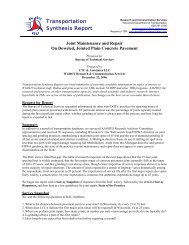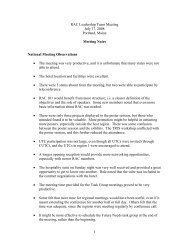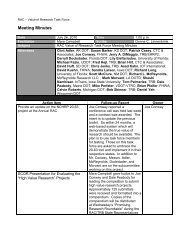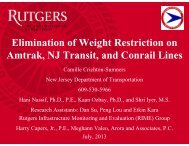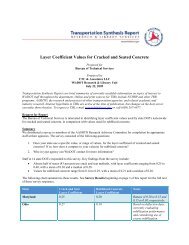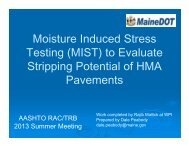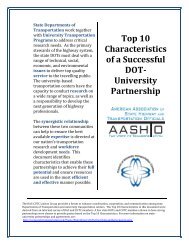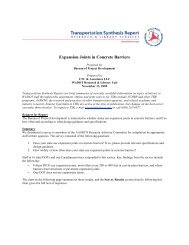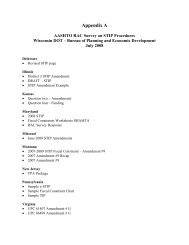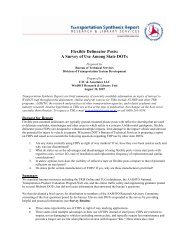PART IV: Summary of Comments - SCOR/RAC
PART IV: Summary of Comments - SCOR/RAC
PART IV: Summary of Comments - SCOR/RAC
Create successful ePaper yourself
Turn your PDF publications into a flip-book with our unique Google optimized e-Paper software.
<strong>PART</strong> <strong>IV</strong>: <strong>Summary</strong> <strong>of</strong> <strong>Comments</strong>17-May-10Reviewer <strong>Comments</strong> Distribution <strong>of</strong> Ratingstensioned, post-tensioned bridges, as well as inspection <strong>of</strong> suspension/staycables. Tasks 1-2 literature survey willindicate a different grouping <strong>of</strong> technologies for wires, tendons, cables/ropes. The intent behind the research is good;however, the scope should be narrowed and focused on one or two specific technologies.Research Advisory Committee■ Very Expensive.■ Cost is too high.■ Too much $$, why not break into phases■ Seems pricey. (Design)■ As Evaluation panel previously noted, this problem statement covers too broad <strong>of</strong> a scope, and this will make it verydifficult to address ass the needs under this research project.Other■ [Rating: 4] Priority #4■ [Rating: 2] Finding NDT tools for this is problematic.Has been studied for deck beams in IL. While high tech techniques are available for inspection, the most cost effective isstill regular hands on inspection with a sounding hammer. If a strand is corroded it should not be considered in analysis.■ SHRP 2 Project R06-A is validating NDT techniques for typical deterioration mechanisms (including corrosion) <strong>of</strong>concrete bridge decks. Finidngs from R06-A could help the initial stages <strong>of</strong> C-04.Item #62:G-02Effectiveness <strong>of</strong> Behavioral Highway SafetyCountermeasures: Turning Research into Practice(17)(46)NR 0 1 2 3 4 5<strong>SCOR</strong> 1 2 5 2 4 3<strong>RAC</strong> 1 3 5 7 14 13 6Standing Committee on Research■ This is some really useful outreach, but it is not really research. It is implementation <strong>of</strong> findings and training.Given thestates' severe funding limitations (<strong>of</strong>ten precluding the implementation <strong>of</strong> any new projects), the timing <strong>of</strong> this proposal isnot good. Also, the funding level is out <strong>of</strong> balance with the scope <strong>of</strong> the work.■ [Rating: 3] This is a NHTSA priority. This is a deployment effort for the info/tech developed in NCHRP Report 622.Research Advisory Committee■ Safety is Ohio's first priority. Behavioral countermeasures are critical to highway safety since the driver accounts for alarge majority <strong>of</strong> crashes, however this research appears to be for developing and hosting workshops on behavioralcountermeasures. We would recommend changing this to a project to develope AMFs for education and enforcementcountermeasures so we know what Rate <strong>of</strong> Return we receive on our investment.■ Wait until 17-46 is scoped and underway■ The estimated cost seem high for developing workshops and pilot tests. The concept <strong>of</strong> focusing on implementation <strong>of</strong>previous research is overdue.■ NCHRP Report 622: Effectiveness <strong>of</strong> Behavioral Highway Safety Countermeasures provides a framework and guidancefor estimating the costs and benefits <strong>of</strong> countermeasures for states to use in finding solutions to problems facing thetransportation community. The problems outlines in Report 622 are <strong>of</strong> nationwide interest as most states share the sameproblems. A current problem associated with this study identified by the authors is how quality evidence concerningeffectiveness <strong>of</strong> behavioral highway safety countermeasures is <strong>of</strong>ten lacking. The project proposes the use <strong>of</strong> regionalworkshops to implement the benefit cost procedures developed under Project 17-33 (NCHRP Report 622). Urgency <strong>of</strong> asolution to this problem is significant as so many Americans are killed and injured every year in the United States. Each<strong>IV</strong>-43



